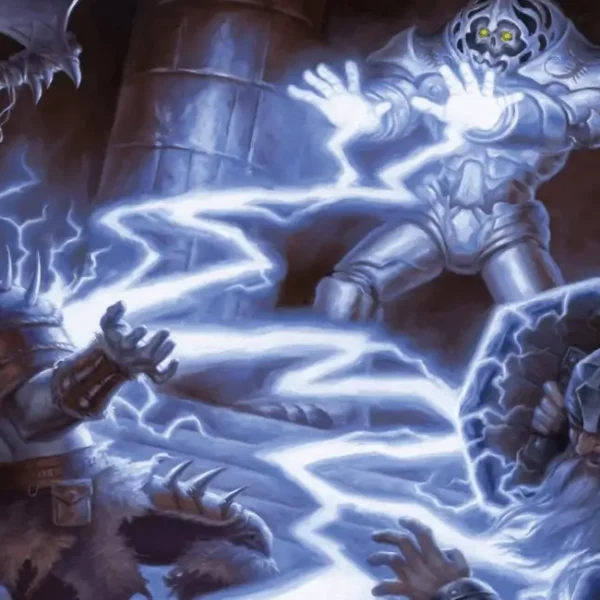Let’s be honest: that cursed tool looks like a lot of fun. Not only does it do a lot of damage, but it also looks really cool and gives you some temporary benefits.
Sure, it might start to eat away at your soul after a long rest, but who needs a soul when you can look so sick?
You do, though.
You need a soul to keep looking cool, but there may be a way to keep using that cool cursed tool without as many bad effects. Remove Curse is the right spell for you.
Have your spellcaster clear it, or do it yourself if you’re the spellcaster, so you can keep killing and taking over the battlefield.
Remove Curse 5e Bottom Line
The spell in this Remove Curse 5e Guide is an abjuration spell of the third level. It has both verbal and physical parts, and to cast it, you have to touch your target. It can break a curse on a person or stop a cursed thing from being connected to that person.
It probably can’t break “high-level” or complex curses, but you can make your own version of Remove Curse that lets you roll against a DC check to try to break a high-level curse.
Remove Curse Basics

Remove Curse is a third-level abjuration spell that takes one action, or about six seconds, to cast. You have to touch your goal and use both verbal and physical parts.
When you cast the spell on your target, all curses on that person, animal, or thing stop.
If the object is a cursed magic item, the curse stays, but the owner’s connection to the object is broken. This lets you get rid of or throw away the object.
Just know that most people who are attuned to a doomed item won’t want to give it up and will do almost anything to make sure their connection stays strong.
What is the School of Abjuration?
The School of Abjuration teaches magic that blocks, sends away, or guards the caster or the person the caster is trying to help.
Remove Curse fits into this group because it gets rid of curses, canceling out their bad effects or getting rid of them altogether when possible.
The School of Abjuration is usually a defensive or reactive school, which is usually undervalued in a normal D&D game, at least in the ones I have played.
If your players are like mine, they might be tempted to use the most powerful spells right away. Still, the best way to defend yourself is to attack, right? Not right.
The best defense is a good defense, and the best defense comes from the School of Abjuration.
Many problems can be solved with brute force and fireballs, but curses aren’t usually ones that can be solved with brute force and fireballs.
How Remove Curse Works?
You can get rid of just about any curse as long as you can touch the item and do the right parts of the spell.
Of course, you also need to remember that this is a third-level spell, which means that it can only remove basic curses or cursed weapons, which usually don’t have complex enchantments.
If a spell like Imprisonment caused a curse of level 9, it’s unlikely that the much weaker Remove Curse will be able to get rid of or undo it.
If you’re not sure, you can try an Arcana check, an Intelligence check, or the spell Identity. When I was a Dungeon Master at my tables, I would use an Arcana check to see if a spell like “Remove Curse” would work.
If, for story purposes or otherwise, you want to give your players a chance to remove a high-level or complicated curse, but you don’t want Remove Curse to be too powerful, I suggest having them cast the spell and then roll to see how well it works.
You can choose what kind of check it is, but I would use their Spellcasting Modifier.
At my table, the DC for a situation like this is 10 + 2 for every level above the third. When I say that the curse is a level, I’m mostly talking about how complicated or hard it is.
The DC check would be 22 for something I would call a “ninth-level” evil or something very complicated.
It might seem like a lot, but they’re trying to break a “ninth-level” curse with a “third-level” spell, which is like trying to use a butter knife to cut through a frozen block of butter.
You’ll get there in the end, but it’s going to be a pain.
Who Can Use Remove Curse?
Only a few types in Dungeons and Dragons 5e can use the Remove Curse ability, but your party is likely to have it. Remove Curse can be found and used by Clerics, Paladins, Warlocks, and Wizards.
Since Clerics and Paladins don’t have to “learn” any of their powers and can use their whole spell sheet right away, the only thing that limits them is their level.
Remove Curse can be used by any Cleric who is at least level five. Paladins, on the other hand, don’t get their first third-level spell slot until level nine. This means that they can’t use Remove Curse until they reach level nine.
Warlocks, on the other hand, can’t learn new skills from scrolls or any other way. If you are a warlock and want to learn the Remove Curse spell, you must do so when you hit level 5 or any level after that.
I would say, though, that if your class is a Cleric, Paladin, or Wizard, there are probably better choices for you.
Wizards are the most flexible because they can learn spells as they level up and get more spell spots, or they can find spells in the game and copy them into their spellbook.
Wizards can take and cast Remove Curse without giving up the ability to learn or cast other things once they reach level five and get their first third-level spell slot.
Getting Creative
Let’s face it, it’s hard to be creative with a spell that only does one thing, but you can do some fun things with it if you combine it with other things. Let’s say your group has a cursed item that does a lot of damage but also has effects that last longer the longer you’re connected to it.
In that case, Remove Curse could let the cursed item be used in fight for a short time before it is put away until it is needed again.
Here’s an exact situation: You have the doomed, self-aware tool called Craven Edge. This sword is a two-handed greatsword that drains the Strength of anyone it hits, drinking their blood and, finally, eating the wielder’s soul.
When this sword is taken out of its sheath, it gives the user a bonus on Intimidation checks and moves Strength from enemies to the user. The target must make a Constitution saving throw of 12 if they are hit. On a failure, Craven Edge takes one point from the target’s Strength score and adds it to the wielder’s Strength score, up to a maximum of 25 points, until the target’s next short or long rest.
When this effect causes a creature’s Strength to drop to zero, the creature instantly dies and the blade eats its soul. This happens whether the creature is out of hit points or not. If the person using Craven Edge has enough Strength to get up to 25 Strength, the blade changes into a much bigger and deadlier-looking one.
In this form, all strikes do an extra 2d6 points of necrotic damage, and the wielder must make a Constitution saving throw with a DC of 16 or their soul is eaten right away, and they die after a short rest.
This means that if you get to the point of the shadowed blade, you can have a +13 to hit and deal 2d6+9 cutting damage plus 2d6 necrotic damage, for a total of 54 slashing and necrotic damage. When you add it to the two hits a level 10 Barbarian has, you can do up to 108 points of damage in a single turn.
If someone has Remove Curse, they can use it to quickly unpair the weapon and get around the instant-death part of Craven Edge. This is because the saving throw needs to be made after a long or short rest.
Depending on how much your DM likes you or how nice they are, this could backfire, and you’ll still need to make a Constitution save. But let’s say you know that your fighter or barbarian is using Craven Edge.
In that case, you can help them get ready by giving them an advantage on Consitution Saving rolls through coaching or something like Bardic Inspiration.
All of this depends on knowing that a member of your party has Craven Edge (or a similar weapon). If your enemies are using Craven Edge and you’re worried they’ll steal your party’s Strength (and, in turn, your souls), you can use Remove Curse as an action to turn the weapon into a normal +2 Great Sword. Even though it can still kill, the chance is much lower.
FAQs
How Do I Get a Cleric to Remove Curses?
If they are level 5, give them a long break so they can put on Remove Curse. If you can’t wait that long, jump around temples until you find a Cleric who has Remove Curse.
Most NPC Clerics are kind enough that they should be ready to help you get rid of the curse (possibly for a small fee), unless you’ve done something really bad to them.
If a priest in your group won’t remove the curse, you might be able to get them to do it by being nice to them.
If the problem keeps happening and it’s the player, not the character, who won’t get rid of it (which means it’s too much for fun and games), talk to the player or see if the DM is ready to talk to them about limits to try to keep the game fun.
Are there other Ways to Remove a Curse in 5e?
Most things in Dungeons and Dragons can be done in more than one way besides the easiest way. Greater Restoration is another power that Clerics, Bards, and Druids can use that does the same things as Remove Curse.
Greater Restoration, on the other hand, is much more expensive. To cast it, you need Diamond Dust worth at least 100 gp. Remove Curse doesn’t need a material component, so it’s best to try it first (and make a DC check to see if your DM will let your table do so).
What Does V S M Mean in Spellcasting Components?
When you make a spell, you can have three different kinds of parts, which are often written as V S M. V stands for “Verbal,” which means that you have to be able to talk in order to cast all or part of the spell.
Somatic means that you have to move (whether it’s just your hands or your whole body for a little flair, it’s up to you) in order to cast all or part of the spell. Material means that the spell can only be cast if you have something that is made of matter.
In general, you don’t need to keep track of most solid components unless you have a spellcasting bag or component bag with you. You should start keeping track of them when they have a value, like 100 gold pieces.
Most parts that don’t have a gold value can be changed with a focus, but from what I’ve seen, most wizards and spellcasters don’t use a focus. No matter what, it’s your choice.










Leave a Comment